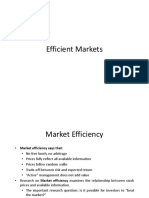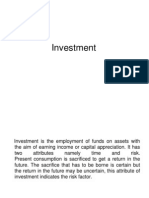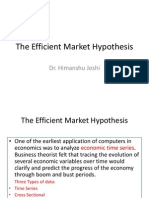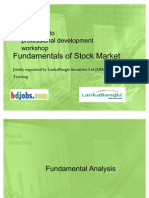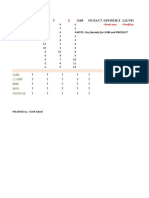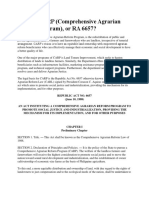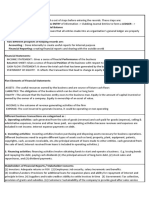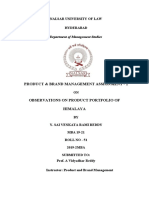0 ratings0% found this document useful (0 votes)
62 viewsChapter 6 Are Financial Markets Efficient
Chapter 6 Are Financial Markets Efficient
Uploaded by
Jay Ann DomeThe document discusses the efficient market hypothesis which states that current stock prices reflect all available information such that prices adjust quickly to new information, eliminating opportunities for arbitrage profits. Evidence in favor of market efficiency includes studies finding investment analysts do not consistently outperform markets and stock prices adjust rapidly to new information. However, some evidence contradicts efficiency, such as small stocks earning higher returns and seasonal stock price patterns.
Copyright:
© All Rights Reserved
Available Formats
Download as PPTX, PDF, TXT or read online from Scribd
Chapter 6 Are Financial Markets Efficient
Chapter 6 Are Financial Markets Efficient
Uploaded by
Jay Ann Dome0 ratings0% found this document useful (0 votes)
62 views12 pagesThe document discusses the efficient market hypothesis which states that current stock prices reflect all available information such that prices adjust quickly to new information, eliminating opportunities for arbitrage profits. Evidence in favor of market efficiency includes studies finding investment analysts do not consistently outperform markets and stock prices adjust rapidly to new information. However, some evidence contradicts efficiency, such as small stocks earning higher returns and seasonal stock price patterns.
Copyright
© © All Rights Reserved
Available Formats
PPTX, PDF, TXT or read online from Scribd
Share this document
Did you find this document useful?
Is this content inappropriate?
The document discusses the efficient market hypothesis which states that current stock prices reflect all available information such that prices adjust quickly to new information, eliminating opportunities for arbitrage profits. Evidence in favor of market efficiency includes studies finding investment analysts do not consistently outperform markets and stock prices adjust rapidly to new information. However, some evidence contradicts efficiency, such as small stocks earning higher returns and seasonal stock price patterns.
Copyright:
© All Rights Reserved
Available Formats
Download as PPTX, PDF, TXT or read online from Scribd
Download as pptx, pdf, or txt
0 ratings0% found this document useful (0 votes)
62 views12 pagesChapter 6 Are Financial Markets Efficient
Chapter 6 Are Financial Markets Efficient
Uploaded by
Jay Ann DomeThe document discusses the efficient market hypothesis which states that current stock prices reflect all available information such that prices adjust quickly to new information, eliminating opportunities for arbitrage profits. Evidence in favor of market efficiency includes studies finding investment analysts do not consistently outperform markets and stock prices adjust rapidly to new information. However, some evidence contradicts efficiency, such as small stocks earning higher returns and seasonal stock price patterns.
Copyright:
© All Rights Reserved
Available Formats
Download as PPTX, PDF, TXT or read online from Scribd
Download as pptx, pdf, or txt
You are on page 1of 12
CHAPTER 6:
ARE FINANCIAL MARKETS
EFFICIENT?
THE EFFICIENT MARKET HYPOTHESIS
• Views expectations as equal to optimal forecasts using all
available information.
• An optimal forecast is the best guess of the future using all
available information. This does not mean that the forecast is
perfectly accurate, but only that it is the best possible given the
available information.
• Implies that the expected return on the security will equal the
optimal forecast of the return.
• Current prices in a financial market will be set so
that the optimal forecast of a security’s return
using all available information equals the
security’s equilibrium return.
• The concept of ARBITRAGE, in which market participants (arbitrageurs)
eliminate unexploited profit opportunities, meaning returns on a security
that are larger than what is justified by the characteristics of that security.
• PURE ARBITRAGE, in which the elimination of unexploited profit
opportunities involves no risk, and
• The type of arbitrage in which the arbitrageur takes on some risk when
eliminating the unexploited profit opportunities.
IN AN EFFICIENT MARKET, ALL UNEXPLOITED PROFIT
OPPORTUNITIES WILL BE ELIMINATED.
• Not everyone in a financial market must be well
informed about a security for its price to be driven
to the point at which the efficient market
condition holds.
EVIDENCE IN FAVOR OF MARKET EFFICIENCY
• 1. Performance of Investment Analysts and Mutual
Funds- when purchasing a security, you cannot expect to
earn an abnormally high return, a return greater than the
equilibrium return.
Having performed well in the past does not indicate
that an investment adviser or a mutual fund will
perform well in the future.
2. Do Stock Prices Reflect Publicly Available
Information?
Favorable earnings announcements or
announcements of stock splits (a division of a share of
stock into multiple shares, which
is usually followed by higher earnings) do not, on
average, cause stock prices to rise.
3. Random-walk Behavior of Stock Prices
• Describes the movements of a variable whose future
changes cannot be predicted (are random) because, given
today’s value, the variable is just as likely to fall as to rise.
Future changes in stock prices should, for all practical
purposes, be unpredictable.
• 4. Technical Analysis- studies past stock price data and
search for patterns such as trends and regular cycles.
Past stock price data cannot help predict changes.
Therefore, technical analysis, which relies on such data
to produce its forecasts, cannot successfully predict
changes in stock prices.
EVIDENCE AGAINST MARKET EFFICIENCY
• 1. Small-Firm Effect- small firms have earned
abnormally high returns over long periods of time, even
when the greater risk for these firms has been taken into
account.
May be due to rebalancing of portfolios by institutional
investors, tax issues, low liquidity of small-firm stocks,
large information costs in evaluating small firms, or an
inappropriate measurement of risk for small-firm stocks.
2. January Effect- stock prices have tended to experience an
abnormal price rise from December to January that is
predictable and hence inconsistent with random-walk behavior.
• due to tax issues
• 3. Market Overreaction- an investor could earn abnormally
high returns, on average, by buying a stock immediately after
a poor earnings announcement and then selling it after a
couple of weeks when it has risen back to normal levels.
4. Excessive Volatility- fluctuations in stock prices may be
much greater than is warranted by fluctuations in their
fundamental value.
5. Mean Reversion- Stocks with low returns today tend to
have high returns in the future, and vice versa.
6. New Information Is Not Always Immediately
Incorporated into Stock Prices
You might also like
- 9.403 Chapter 4: Efficient Securities MarketsDocument10 pages9.403 Chapter 4: Efficient Securities MarketsYanee ReeNo ratings yet
- Course Description: Matthew Mark - Jet CapitalDocument1 pageCourse Description: Matthew Mark - Jet CapitalInnerScorecardNo ratings yet
- Objection Letter - 6Document2 pagesObjection Letter - 6stockboardguy100% (1)
- Market Efficiency PDFDocument17 pagesMarket Efficiency PDFBatoul ShokorNo ratings yet
- 06 - Market Efficiency and Behavioral FinanceDocument35 pages06 - Market Efficiency and Behavioral FinanceGabriel TNo ratings yet
- Lecture 7aDocument23 pagesLecture 7aThilina PremjayanthNo ratings yet
- 06 - Market Efficiency and Behavioral FinanceDocument40 pages06 - Market Efficiency and Behavioral FinanceDaniel RisticNo ratings yet
- Lecture Week12 Behavior FinanceDocument26 pagesLecture Week12 Behavior FinanceYaonik HimmatramkaNo ratings yet
- Lec 11Document20 pagesLec 11Ritik KumarNo ratings yet
- Treasury Management Presentation Group 6Document24 pagesTreasury Management Presentation Group 6David AkoNo ratings yet
- Slides s15 ClassgroupDocument41 pagesSlides s15 ClassgroupJohn DoeNo ratings yet
- JOSEDocument5 pagesJOSEWillhem PhillyNo ratings yet
- Chapter 1-6 InvestmentDocument142 pagesChapter 1-6 InvestmentDuolWuorChuolNo ratings yet
- Module 5.1. Market Anomalies - Behavioural.psychological - FactorsDocument30 pagesModule 5.1. Market Anomalies - Behavioural.psychological - FactorsakwoviahNo ratings yet
- Unit 1Document9 pagesUnit 1Mohd. Imran SiddiqueNo ratings yet
- TOPIC 7 & 8 - Portfolio MGTDocument15 pagesTOPIC 7 & 8 - Portfolio MGTDaniel DakaNo ratings yet
- Equity Security AnalysisDocument9 pagesEquity Security Analysisliangd123No ratings yet
- CH 9 AplkDocument9 pagesCH 9 AplkRia TriyantiNo ratings yet
- Approaches To Investment Decision MakingDocument3 pagesApproaches To Investment Decision MakingvinodhknatrajanNo ratings yet
- Ecm 4fmeDocument25 pagesEcm 4fmeMark BautistaNo ratings yet
- Upload SapmDocument20 pagesUpload SapmQurath ul ainNo ratings yet
- Chapter 9Document10 pagesChapter 9Irwan AdimasNo ratings yet
- A Philosophical Basis For ValuationDocument87 pagesA Philosophical Basis For ValuationaugustoNo ratings yet
- Financial Markets and InstitutionDocument32 pagesFinancial Markets and InstitutionDavid LeowNo ratings yet
- Efficient Market Hypothesis1Document45 pagesEfficient Market Hypothesis1kilongosabrina7No ratings yet
- Investment Analysis - Chapter 10Document16 pagesInvestment Analysis - Chapter 1021070460 Ngô Thị Hải BìnhNo ratings yet
- 9.0 Efficient MarketDocument5 pages9.0 Efficient MarketSITI LAILA AZWA AZMANNo ratings yet
- Unit 1 Financial Management IIDocument5 pagesUnit 1 Financial Management IIjoseguticast99No ratings yet
- Bman71132 L6 - 2023-24Document38 pagesBman71132 L6 - 2023-24Kamran HacızadəNo ratings yet
- Chapter 4Document16 pagesChapter 4maham rasheedNo ratings yet
- Im Ist UnitDocument23 pagesIm Ist Unitvarigantieshwar2000No ratings yet
- Anatomy of LegDocument14 pagesAnatomy of LegPriscilla LawrenceNo ratings yet
- Portfolio MGTDocument98 pagesPortfolio MGTNishantNo ratings yet
- 4. 5%Document7 pages4. 5%shanthimkr1996No ratings yet
- Chapter 1 Introduction To Fundamental AnalysisDocument61 pagesChapter 1 Introduction To Fundamental AnalysisDarshan ShahNo ratings yet
- Investment and Portfolio ManagementDocument7 pagesInvestment and Portfolio ManagementDeepak ShindeNo ratings yet
- Investment AttributesDocument4 pagesInvestment AttributesNiranjan PhuyalNo ratings yet
- Introduction To ValuationDocument5 pagesIntroduction To ValuationRG VergaraNo ratings yet
- Corporate Financing Decisions and Efficient Capital MarketsDocument30 pagesCorporate Financing Decisions and Efficient Capital MarketsUniversity Securities Investment TeamNo ratings yet
- FIN630 Short Notes For Lecture 23-45 by Humaira PDFDocument45 pagesFIN630 Short Notes For Lecture 23-45 by Humaira PDFsohaib shahidNo ratings yet
- S 15 - Efficient Capital Markets and Behavioral ChallengesDocument27 pagesS 15 - Efficient Capital Markets and Behavioral ChallengesAninda DuttaNo ratings yet
- Valuation Concepts and Methods Introduction To ValuationDocument18 pagesValuation Concepts and Methods Introduction To ValuationPatricia Nicole BarriosNo ratings yet
- Investments: An IntroductionDocument150 pagesInvestments: An IntroductionNitin NimkarNo ratings yet
- The Theory of Capital Markets: Rational Expectations and Efficient MarketsDocument27 pagesThe Theory of Capital Markets: Rational Expectations and Efficient MarketsPranay WaniNo ratings yet
- Security Analysis and Portfolio ManagementDocument24 pagesSecurity Analysis and Portfolio Managementkum_popNo ratings yet
- Chapter 13 Market EfficiencyDocument2 pagesChapter 13 Market EfficiencySajib KarNo ratings yet
- Introduction To The Concept of Risk and ReturnDocument31 pagesIntroduction To The Concept of Risk and ReturnSaish Chavan100% (1)
- Chapter 2 EFFICIENT EQUITY MARKETSDocument19 pagesChapter 2 EFFICIENT EQUITY MARKETSathirasakinah98No ratings yet
- Topic 1 - Understanding Investments & Investment Alternatives (STU) - Đã G PDocument280 pagesTopic 1 - Understanding Investments & Investment Alternatives (STU) - Đã G PThanh XuânNo ratings yet
- InvestmentsDocument60 pagesInvestmentsKristy SullivanNo ratings yet
- The Efficient Market HypothesisDocument70 pagesThe Efficient Market HypothesisPurv MehraNo ratings yet
- STOCK RISKDocument35 pagesSTOCK RISKkaushiki.keshriNo ratings yet
- Module 3, Day 5Document20 pagesModule 3, Day 5praveshNo ratings yet
- PHP CP9Document28 pagesPHP CP9chandra dwiNo ratings yet
- Emh 2Document50 pagesEmh 2ba22samyukthaNo ratings yet
- Security Analysis and Portfolio ManagementDocument114 pagesSecurity Analysis and Portfolio ManagementSimha Simha100% (1)
- Secondary MarketDocument62 pagesSecondary MarketKnishka VermaNo ratings yet
- Unit 2Document47 pagesUnit 2Banhi GuhaNo ratings yet
- BD Job Traning Session 4Document58 pagesBD Job Traning Session 4Mamun ReturnNo ratings yet
- Sapm 1 & 2Document73 pagesSapm 1 & 2Vandita KhudiaNo ratings yet
- Common Stocks: Analysis & StrategyDocument39 pagesCommon Stocks: Analysis & StrategyzeshanNo ratings yet
- Mariah Carey LyricsDocument3 pagesMariah Carey LyricsJay Ann DomeNo ratings yet
- Break Up With Youe GFDocument3 pagesBreak Up With Youe GFJay Ann DomeNo ratings yet
- Super BassDocument4 pagesSuper BassJay Ann Dome100% (1)
- Marshmello & Bastille Lyrics: "Happier"Document2 pagesMarshmello & Bastille Lyrics: "Happier"Jay Ann DomeNo ratings yet
- Destiny Rogers LyricsDocument2 pagesDestiny Rogers LyricsJay Ann DomeNo ratings yet
- Ella Mai Lyrics: "She Don't"Document2 pagesElla Mai Lyrics: "She Don't"Jay Ann DomeNo ratings yet
- Quiz 1Document3 pagesQuiz 1Jay Ann DomeNo ratings yet
- Ariana Grande LyricsDocument2 pagesAriana Grande LyricsJay Ann DomeNo ratings yet
- LISA LyricsDocument3 pagesLISA LyricsJay Ann DomeNo ratings yet
- New Romantics - Taylor SwiftDocument2 pagesNew Romantics - Taylor SwiftJay Ann DomeNo ratings yet
- Favorite Crime - Olivia RodrigoDocument2 pagesFavorite Crime - Olivia RodrigoJay Ann DomeNo ratings yet
- 2 Cor 18Document12 pages2 Cor 18Jay Ann DomeNo ratings yet
- Functions SUM Product Difference Quotient: SUM Count MIN MAX AverageDocument4 pagesFunctions SUM Product Difference Quotient: SUM Count MIN MAX AverageJay Ann DomeNo ratings yet
- Billie Eilish LyricsDocument3 pagesBillie Eilish LyricsJay Ann DomeNo ratings yet
- Justin Bieber Lyrics "Confident" (Feat. Chance The Rapper)Document4 pagesJustin Bieber Lyrics "Confident" (Feat. Chance The Rapper)Jay Ann DomeNo ratings yet
- Commissioned With The Ministry of Reconciliation For The Lord'S New CreationDocument18 pagesCommissioned With The Ministry of Reconciliation For The Lord'S New CreationJay Ann DomeNo ratings yet
- A Book On Living Christ For The ChurchDocument15 pagesA Book On Living Christ For The ChurchJay Ann DomeNo ratings yet
- Partnership Problems Partnership Problems: Accountancy (La Consolacion College) Accountancy (La Consolacion College)Document35 pagesPartnership Problems Partnership Problems: Accountancy (La Consolacion College) Accountancy (La Consolacion College)Jay Ann DomeNo ratings yet
- A Personal TestimonyDocument9 pagesA Personal TestimonyJay Ann DomeNo ratings yet
- MANDALADocument1 pageMANDALAJay Ann DomeNo ratings yet
- Partnership Formation and OperationDocument41 pagesPartnership Formation and OperationJay Ann DomeNo ratings yet
- Barrios, Mila JoyDocument6 pagesBarrios, Mila JoyJay Ann DomeNo ratings yet
- Functions SUM Product Difference Quotient: SUM Count MIN MAX AverageDocument4 pagesFunctions SUM Product Difference Quotient: SUM Count MIN MAX AverageJay Ann DomeNo ratings yet
- What Is CARPDocument25 pagesWhat Is CARPjunmiguelNo ratings yet
- Final Soul ShoesDocument64 pagesFinal Soul Shoesadeel100% (3)
- Ratio and Proportion Questions For Bank Prelims Exam - Set 1Document5 pagesRatio and Proportion Questions For Bank Prelims Exam - Set 1captainharshit2004No ratings yet
- Automotive Tyre Manufacturers' Association (ATMA)Document21 pagesAutomotive Tyre Manufacturers' Association (ATMA)flower87No ratings yet
- Siyon de ALwis Profile FinalDocument2 pagesSiyon de ALwis Profile FinalSiyon De AlwisNo ratings yet
- PTBA Presentation 9M2015Document24 pagesPTBA Presentation 9M2015apurnomoNo ratings yet
- BMI Vietnam Freight Transport Report Q2 2014Document89 pagesBMI Vietnam Freight Transport Report Q2 2014BiểnLêNo ratings yet
- Kalyan Jewellers - Er ReportDocument15 pagesKalyan Jewellers - Er ReportSudharsanNo ratings yet
- Financial Accounting BasicsDocument2 pagesFinancial Accounting Basicssmartanand2009No ratings yet
- Disney & PixarDocument24 pagesDisney & PixarIBS Team5No ratings yet
- Fridah Dissertation-Final For BindingDocument51 pagesFridah Dissertation-Final For BindingDennis NemesisBellarin RichardNo ratings yet
- Fitta 2075Document25 pagesFitta 2075Sandhya BasnetNo ratings yet
- Personal StatementDocument6 pagesPersonal StatementomondistepNo ratings yet
- Laporan Keuangan Tahun 2018Document264 pagesLaporan Keuangan Tahun 2018Weni PatandukNo ratings yet
- 21521sm Finalnew Vol2 Cp2Document208 pages21521sm Finalnew Vol2 Cp2Kushal BhatiaNo ratings yet
- Patanjali Ayurved Limited: Detailed ReportDocument16 pagesPatanjali Ayurved Limited: Detailed Reportb0gm3n0tNo ratings yet
- FNB 308: Merchant and Investment Banking Corporate Finance & SyndicationDocument19 pagesFNB 308: Merchant and Investment Banking Corporate Finance & SyndicationFarjana Hossain DharaNo ratings yet
- Reasons For M&A: by Prof. P.m.nayakDocument13 pagesReasons For M&A: by Prof. P.m.nayakPradeep BandiNo ratings yet
- SVBDocument7 pagesSVBrajaNo ratings yet
- Business and Society Chapter 2Document22 pagesBusiness and Society Chapter 2Haider CasanovaNo ratings yet
- GROUP 2 Family Case Wealth ManagementDocument18 pagesGROUP 2 Family Case Wealth ManagementAparna KalaskarNo ratings yet
- IAPM Case Study History AppendedDocument11 pagesIAPM Case Study History AppendedPratikJainNo ratings yet
- ch15 PDFDocument9 pagesch15 PDFRetno Tri SeptiyaniNo ratings yet
- MMBC Data Sheet: Barrels Needed To Recover Loss in ContributionDocument5 pagesMMBC Data Sheet: Barrels Needed To Recover Loss in ContributionmayurmachoNo ratings yet
- Product & Brand Management Assignment - 2: Nalsar University of Law HyderabadDocument5 pagesProduct & Brand Management Assignment - 2: Nalsar University of Law HyderabadreddyNo ratings yet
- Study The Awareness of Mutual Fund in Mumbai PDFDocument48 pagesStudy The Awareness of Mutual Fund in Mumbai PDFnikki karma100% (1)
- Fund Flow TheoryDocument3 pagesFund Flow TheoryxavierjosephNo ratings yet
- Rate CalculatorDocument6 pagesRate CalculatormcpayodNo ratings yet








